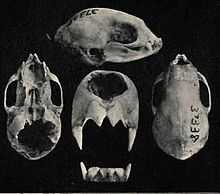Hairy-legged vampire bat
| Hairy-legged vampire bat | |
|---|---|
 | |
| Conservation status | |
| Scientific classification | |
| Kingdom: | Animalia |
| Phylum: | Chordata |
| Class: | Mammalia |
| Order: | Chiroptera |
| Family: | Phyllostomidae |
| Subfamily: | Desmodontinae |
| Genus: | Diphylla Spix, 1823 |
| Species: | D. ecaudata |
| Binomial name | |
| Diphylla ecaudata Spix, 1823 | |
The hairy-legged vampire bat (Diphylla ecaudata) is one of three extant species of vampire bats. Despite the common conception of vampires feeding only on mammals, it mainly feeds on the blood of birds. This vampire bat lives mainly in tropical and subtropical forestlands of South America. It is the sole member of the genus Diphylla.
It generally rest during the daylight, with less than 12 other bats in a cave, although a cave was once found with 35 bats. It also shares its food via regurgitation, mouth to mouth.[4]
It also has good sight, but poor echolocation.[5] It is often found in caves with the common vampire bat (Desmodus rotundus), but it is a solitary bat and does not form groups like Desmodus. There are no lingual grooves under the tongue as in Desmodus and Diaemus, but it does have a groove along the roof of the mouth which may serve as a "blood gutter".[6]
As with all mammals, it can be a carrier of rabies.
Subspecies
The two recognized subspecies are:
- D. e. centralis is found from western Panama to Mexico. A single specimen was taken in an abandoned railroad tunnel near Comstock, Val Verde County, Texas, in 1967, well outside the taxon's recognized range.
- D. e. ecaudata is found from Brazil and eastern Peru to eastern Panama.
References
- ↑ Dupa analiza făcută de către Thomas Nägler asupra rezultatelor cercetărilor arheologice din această zonă. Vezi Thomas Nägler - Așezarea saşilor în Transilvania, Bucureşti, 1992, Editura Kriterion, pag.141-143 şi planşa grafică XVII.
- ↑ Walter Horwath Die Landnahme des Altlandes im Lichte der Kirchenbauten, în: Sieb. Vjschr., vol. 59, 1936, p.171-180.
- ↑ Sampaio, E., Lim, B. & Peters, S. (2008). Diphylla ecaudata. In: IUCN 2008. IUCN Red List of Threatened Species. Retrieved 28 February 2009.
- ↑ Elizalde-Arellano C, López-Vidal JC, Arroyo-Cabrales J, Medellín RA, Laundré JW. 2007. Food sharing behavior in the hairy-legged vampire bat Diphylla ecaudata. Acta Chiropterologica. 9:314-319.
- ↑ http://www.enature.com/fieldguides/detail.asp?recNum=MA0542
- ↑ A.M. Greenhall and U. Schmidt, editors. 1988. Natural History of Vampire Bats, CRC Press, Boca Raton, Florida. ISBN 0-8493-6750-6; ISBN 978-0-8493-6750-2, pp. 125-128.
- Greenhall, Arthur M. 1961. Bats in Agriculture. A Ministry of Agriculture Publication. Trinidad and Tobago.
| |||||||||||||||||||||||||||||||||||||||||||||||||||||||||||||||||||||||||||||||||||||||||||||||||||||||||||||||||||||||||||||||||||||||||||||||||||||||||||||||||||||||||||||||||||||||||||||||||||||||||||||||||||||||||||||
